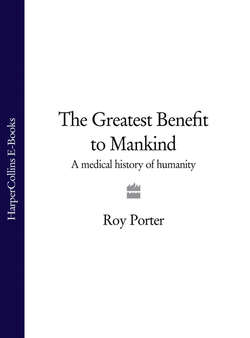Читать книгу The Greatest Benefit to Mankind: A Medical History of Humanity - Roy Porter - Страница 42
MADNESS
ОглавлениеAlongside leprosy and plague, another condition of public concern was insanity. Madness remained particularly disputed. On Galen’s authority, medical writers distinguished four main categories: frenzy, mania, melancholy and fatuity, each the result of a particular humoral imbalance. Folklore believed the moon caused lunacy; theology saw it as a consequence of diabolical possession or sorcery. Some viewed it as divinely inspired, perhaps involving the gift of tongues; others praised the innocence of the village idiot; while troubadours might sing of tragic love-madness.
Nor was there agreement over remedies. Some advocated drugs and bleeding to sedate the demented and evacuate peccant humours. Shock treatment might be tried, such as hurling a maniac into a river. For demoniacal possession, there was exorcism, while certain saints had the power to cure madness. Three shrines enjoyed a special reputation: St Mathurin at Larchant and St Acairius at Haspres (both in northern France), and St Dymphna at Geel in Flanders. A hospice built there to house the mentally ill proved too small and many were lodged in village households. From this a special ‘family colony’ developed, in which the mentally ill were tended by the villagers. The Geel community still exists.
Public attitudes towards the insane were mixed. German municipalities sometimes expelled idiots or insane persons, whipping them out of town – though the celebrated ‘ship of fools’ is not a reality but a literary conceit, symbolizing humanity’s follies. The insane were cared for in monasteries; various towns had madmen’s towers (Narrentürme); in Paris, special cells were set aside at the Hôtel Dieu; and the Teutonic Knights’ hospital at Elbing had a madhouse (Tollhaus). Specialized hospitals began to appear, notably under the influence of Islam in Spain: Granada (1365), Valencia (1407), Zaragoza (1425), Seville (1436), Barcelona (1481) and Toledo (1483). The priory of St Mary of Bethlehem in London, founded in 1247, was by 1403 housing six men ‘deprived of reason’; it developed into the notorious Bedlam. Such moves towards incarceration were counterbalanced by the image of the mad person as a holy fool, while in the ‘feast of fools’ medieval society came to terms with mental alienation through the carnival notion of the world turned upside down – madness as dionysian release.
The insane also became linked to witchcraft, with demonic possession serving as an explanation for deranged behaviour. Haunted by plague and heresy, the late medieval church warned against the Devil and his minions; women were considered particularly susceptible to Satan; and during the next 300 years the witch-craze seized Europe, leading to the execution, often after judicial torture, of upwards of 50,000 victims, mainly women (the figure of nine million burnings, often cited in feminist writings, is pure fantasy).
An individual of whom much is known is the English mystic, Margery Kempe (b. 1393). A wealthy woman who owned a brewery in King’s Lynn, she fell victim to puerperal insanity and began to behave oddly. Undertaking pilgrimages to Jerusalem, Rome and Spain, she described her spiritual experiences. The Book of Margery Kempe (c. 1423), perhaps the very first English autobiography, reveals the contested borderland between illness and religious experience. To some of her companions she was a sick woman, indeed a confounded nuisance with her non-stop wailings; to others, she was the mouthpiece of God – or was possessed by the Devil. ‘Many said’, she wrote,
there was never saint in heaven that cried as she did, and from that they concluded she had a devil within her which caused that crying. And this they said openly, amid much more evil talk. She took everything patiently for our Lord’s love, for she knew very well that the Jews said much worse of His own person than people did of her, and therefore she took it the more meekly.
